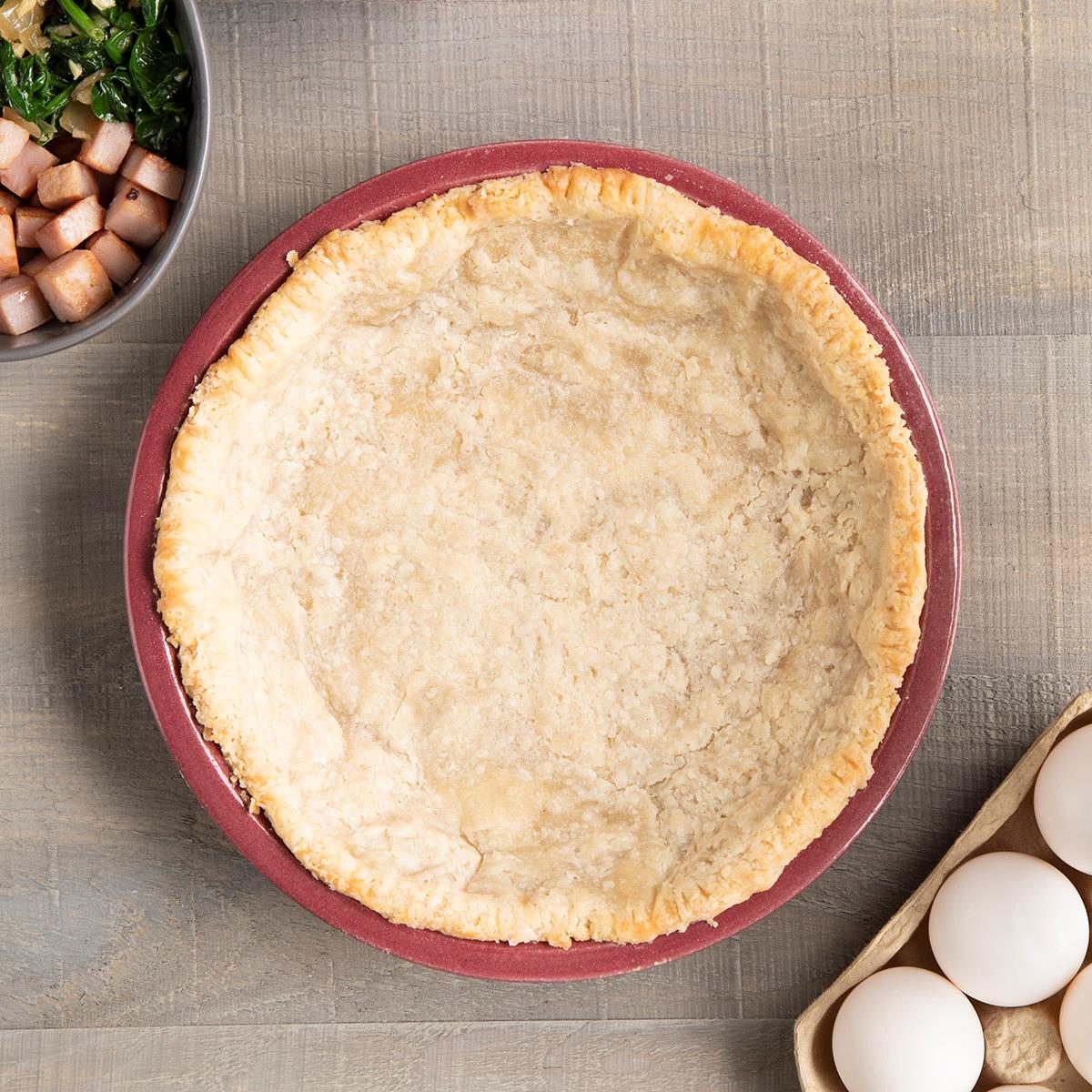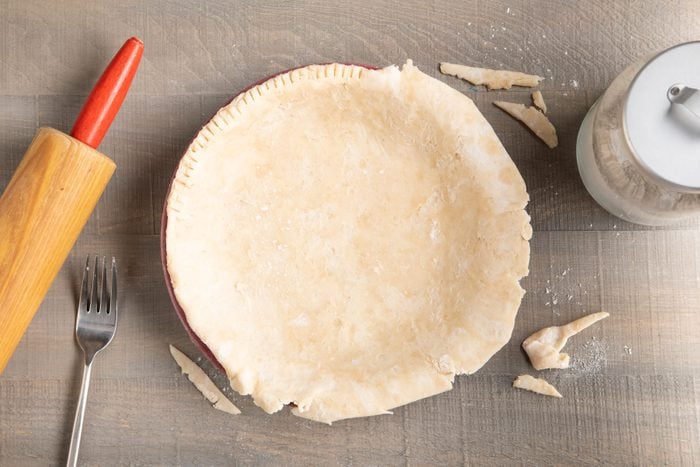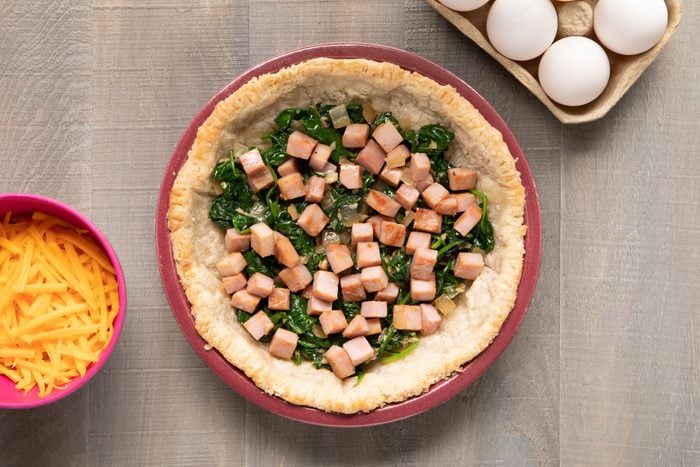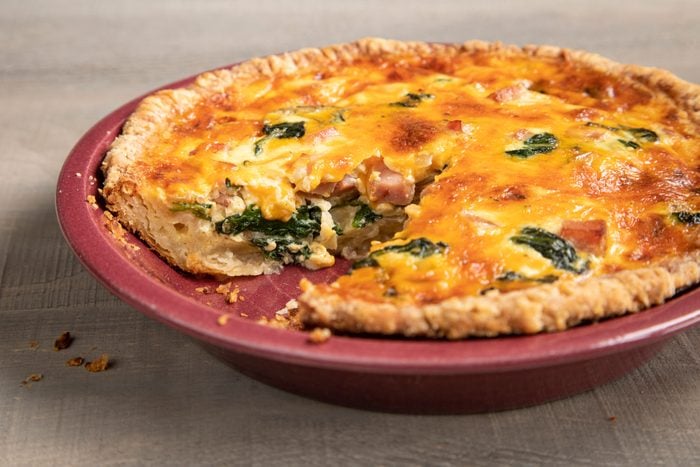Mom always knows best, and using lard in pie crust is just one of the many ways she proves it. This lard pie crust makes a single crust and is easy to double, if need be.

Lard Pie Crust

Get ready for your flakiest pie yet! Lard pie crust is the preferred homemade pie crust recipe in some homes because of its ultra-flaky, easy-to-work-with nature. Lard blends nicely and doesn’t melt quite as easily as butter does, which are two crucial characteristics to consider when choosing what type of fat it use in pie crust. Don’t let the fear of a less common ingredient keep you from trying out this pie crust dough with your favorite pie recipes.
Ingredients for Lard Pie Crust
- Lard: Because there are so few ingredients used in this pie crust recipe with lard, the quality of each ingredient matters, especially the lard. Leaf lard is the best lard quality you can buy. Regular lard will work in this recipe, too.
- All-purpose flour: We love using all-purpose flour for our pie crust recipes. This popular type of flour adds the perfect amount of structure while maintaining a tender texture.
- Salt: Don’t use salt that has larger granules. You’ll want a finer consistency, so the salt evenly disperses in the pie dough.
- Water: When I’m making a pie crust, I like to fill a liquid measuring cup with water and ice and let it sit for a few minutes so the water can get really cold. Then, I take my tablespoon measurement out and measure the water from the ice-cold water right into my pie dough.
Directions
Step 1: Cut the lard into the flour
In a small bowl, whisk together the flour and salt. Cut in the lard until the mixture is crumbly and the pieces of lard are pea-sized.
Editor’s Tip: Work quickly to keep your ingredients as cold as possible so the lard doesn’t melt into the flour, messing up the possibility of flaky layers. I like to keep all my pie ingredients (yes, even the flour!) in the fridge for a bit until I’m ready to use them to ensure everything stays chilled.
Step 2: Add the water
Gradually add the cold water one tablespoon at a time, tossing with a fork until the dough holds together when pressed.
Editor’s Tip: Avoid over-mixing the pie crust dough as much as possible. Over-mixing can create a tough pie crust instead of a tender one.
Step 3: Chill
Shape the pie dough into a disk. Wrap the disk tightly in storage wrap and refrigerate the dough for at least one hour or chill overnight.
Step 4: Roll out the dough
On a lightly floured surface, roll the dough out to a 1/8-inch-thick circle. Roll from the center of the dough and move outward to the edges. To help ensure an even shape and prevent the dough from sticking, give the dough a quarter turn after each roll. If you feel your dough is still sticking to the counter or the rolling pin, add more flour.
Transfer the dough to a 9-inch or 10-inch pie plate.
Editor’s Tip: Use a pastry brush to wipe away any excess flour. It’s one of our best secrets for rolling out pie dough!
Step 5: Cut and bake

Trim the crust to a 1/2 inch beyond the rim of the plate. Shape the edges with a fluting pattern or another decorative pie crust design.
Refer to your pie crust recipe’s directions to either fill or bake the pie crust.
Recipe Variations

- Add herbs: A characteristic we love about pie crust is that it can be used for sweet or savory pies. When making savory pie recipes, add fresh minced herbs like chives, parsley, rosemary, thyme, sage or basil to the pie crust for flavor and fragrance.
- Sprinkle in sugar: If you’re making a sweet pie, feel free to add a tablespoon of granulated sugar to the pie crust recipe with lard. It’ll subtly sweeten the crust and add browning power for a gorgeous, golden-brown pie.
- Blind bake the crust: If you’re wondering if you can blind bake this lard pie crust, you totally can! Blind baking is best for pie recipes whose fillings do not bake, such as cream pies, pudding pies or pie fillings that are baked on the stovetop (like lemon meringue pie).
How to Store Lard Pie Crust
To store unbaked lard pie crust, wrap the dough tightly in storage wrap and keep it in the fridge for up to three days. Thaw at room temperature until it’s easy to work with but still chilled, 15 to 30 minutes.
Can you freeze lard pie crust?
Yes, you can freeze unbaked lard pie crust. To do so, wrap the dough tightly in a few layers of storage wrap. Freeze the dough for up to three months. Thaw the pie crust overnight in the fridge, then at room temperature until it’s easy to work with but still chilled, 15 to 30 minutes.
Lard Pie Crust Tips

Where can you find lard for lard pie crust?
Lard is available in most grocery stores and is usually located near the shortening and oils. There are two types of lard you can purchase: regular and leaf lard. Both types work for this crust, although bakers rate leaf lard higher than regular lard. However, leaf lard comes at a price premium. Leaf lard is also a bit harder to find than regular lard, but a good place to look for this ingredient is the meat counter at a grocery store or at a butcher’s shop.
Can you use butter instead of lard when making this pie crust recipe?
Yes, you can make a substitution, but in the case of lard and butter, it’s not a straight one-to-one swap. If you’re using butter, add an extra tablespoon per 1/4 cup. (Or skip the conversions and use our classic all-butter pie crust recipe.) Shortening, like lard, is 100% fat, so you could do a direct one-to-one substitution.
Do you have to chill the lard pie crust dough before rolling it out?
Yes, you have to chill the dough before rolling it out. It’s also a good idea to chill the crust after you’ve put it in the pie plate for extra insurance.
Mom's Lard Pie Crust
Ingredients
- 1-1/2 cups all-purpose flour
- Pinch salt
- 1/2 cup lard
- 3 to 4 tablespoons cold water
Directions
- In a small bowl, mix flour and salt; cut in lard until crumbly. Gradually add cold water, tossing with a fork until dough holds together when pressed. Shape into a disk; wrap and refrigerate 1 hour or overnight.
- On a lightly floured surface, roll dough to a 1/8-in.-thick circle; transfer to a 9-in. or 10-in. pie plate. Trim crust to 1/2 in. beyond rim of plate; flute edge. Fill or bake shell according to recipe directions.
Nutrition Facts
1 piece: 201 calories, 13g fat (5g saturated fat), 12mg cholesterol, 19mg sodium, 18g carbohydrate (0 sugars, 1g fiber), 2g protein.

















